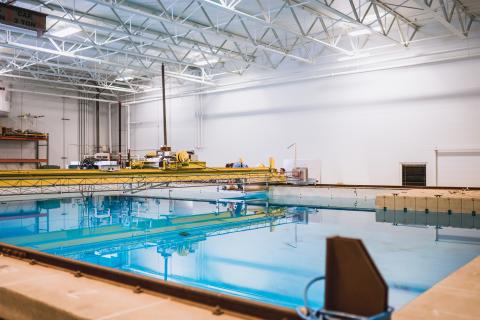
The engineering and tow/wave tanks are available for research activities only to UNH researchers and students. UNH researchers and students, please use the links below to reserve a tank. Before submitting your reservation, please check the tank calendar to ensure the tank is available during your requested time.
External users, please email marine.information@unh.edu to inquire about tank usage.
Users of the tanks must observe all safety rules, including:
- Any person who witnesses an act related to the use of the tank which causes them to be concerned for the safety of either personnel, equipment, or any part of the facility, has the right to stop work in the facility and discuss/resolve the safety issue either directly with the users of the tank or the facilities manager.
- Wearing coast-guard approved personal flotation devices (provided) while on the tank apron or over the water.
- Proper clothing (e.g., no loose ends) and footwear (e.g., no open toes, steel toes for heavy lifts).
- A minimum of two personnel must be present at all times.
- Cranes, forklifts, or other machinery may not be operated without the express consent of a responsible UNH party (e.g., Technical Support Center Staff, Faculty Leads, or Center Director).
- Any diving MUST be approved by UNH’s Diving Program Officer, Elizabeth Kintzing (Elizabeth.kintzing@unh.edu).
Engineering Tank
The engineering tank in the ocean engineering lab is a deep water testing basin. The 60 x 40 x 20 foot tank is used for a variety of experiments where simulating unobstructed, open water environments is required. Several additional components offer a variety of testing platforms. For example, the acoustic profiling tower can be used to test hydrophonic transducers for array shape and intensity. The mounting apparatus is capable of a full 360 degree sweep and 40 degree elevation at 1/10 degree resolution.

Tow/Wave Tank
The tank measures 12’ x 8' x 120’ and enables research that involves towing test bodies and subjecting them to wave action. Wave action is possible using a hydraulic wave generator that can produce 2- to 5-second waves that are up to half a meter in height. Review details on tank equipment and accessories here.
Tank reservation link for UNH researchers and students only:
